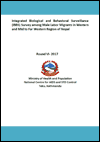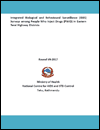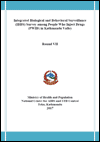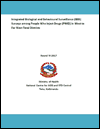What's New
Displaying results 1721 - 1730 of 4922

Resource | Publications,
This is the first round of the IBBS survey conducted among Female Injecting Drug Users (FIDUs) in Pokhara Valley. The females of 16 years and above who had been injecting
drugs for at least three months preceding the survey were defined as FIDUs and enrolled in the survey. School of Planning Monitoring Evaluation and Research (SPMER) carried
out this survey from December 2016 to May 2017 under the leadership of NCASC. The survey was undertaken primarily to determine the prevalence of HIV, Syphilis, Hepatitis B
(HBV) and Hepatitis C (HCV) infection among FIDUs.

Resource | Publications,
This IBBS Survey among FSWs (FSWs) in Kathmandu Valley is sixth round of Survey. It was conducted first time in 2004. The survey was undertaken primarily to track the trend of HIV infection, to access information about the safe sex practices, sexual behavioral, knowledge of HIV and STI, explore the association between risk behaviors and infections with HIV or STI. More specifically, the survey was conducted to collect socio-demographic characteristics; alcohol and drug use and needle sharing behaviors; the experience of stigma, discrimination and physical, sexual and other forms of violence; and exposure to HIV and AIDs program.

Resource | Publications,
The survey was undertaken primarily to track the trend of HIV prevalence among MLMs and to understand risky sexual behaviors among MLMs of Western and Mid to Far Western Regions of Nepal. Information on the socio-demographic characteristics, work and migration, sexual behavior and condom use with different partners in Nepal and during the stay in India; knowledge perception and attitude on HIV/AIDS and STI; use of drug and injection; exposure to STI, HIV and AIDS awareness programs; and stigma/discrimination against HIV infected person were collected using a structured questionnaire.

Resource | Publications,
This is the sixth round of IBBS survey conducted among men who have sex with men (MSM) and Transgender (TG) population in the Kathmandu valley of Nepal. Previously, the survey was carried out in 2004, 2007, 2009, 2012, 2015 and 2017 in the same location among the same population. In line with the objectives of previous rounds of IBBS, this survey was undertaken primarily with the objectives to: a) determine the trend of HIV, Syphilis, Chlamydia Trachomati (CT) and Neisseria Gonorrhea (NG) and associated risk behaviors among MSM/ Transgender (TG), b) to assess socio demographic characteristics, and, c) explore the association between the risk behaviors and HIV and other specific STIs among the MSM and TG population.

Resource | Publications,
HIV in Nepal is characterized as a concentrated epidemic. Nepal is categorized as a country facing concentrated HIV epidemic. The National Centre for AIDS and STD Control (NCASC) has estimated that there were 39,249 people living with HIV (PLHIV) in Nepal in 2014 with adult HIV prevalence 0.20% (NCASC, 2014). The National HIV/AIDS strategy 2011-2016 has adopted strengthening of the Second Generation Surveillance(SGS) system as one of the key principles of strengthening surveillance of HIV and STI in Nepal.

Resource | Publications,
Injection of drugs is strongly linked to HIV because of the higher rate of HIV transmission through needles. Syringe use and needle sharing habits are one of the key behavioral factors that act as the principle driver in the transmission of HIV and other blood borne pathogens. Findings obtained from the previous survey have shown that the prevalence of HIV in PWID ranges from 22 percent in 2003, 21.7 percent in 2005, 6.8 percent in 2007, 3.4 percent in 2009, 4.6 percent in 2011 to 2.8 percent in 2015 in Pokhara valley.

Resource | Publications,
IBBS surveys have been successfully conducted in various rounds in Nepal for the last about a decade among key populations at higher risk for HIV. Different round of IBBS were successfully carried out under leadership of NCASC .Evidences from different rounds of IBBS surveys carried out in Nepal suggest that HIV prevalence is still high among PWID compared to other Key population such as Female Sex workers (PWID) and Male having sex with Male (MSM). This is six round of IBBS surveys among PWID West to Far West Terai Districts.

Resource | Publications,
According to the results of the 2017 Revision, the world’s population numbered nearly 7.6 billion as of mid-2017, implying that the world has added approximately one billion people over the last twelve years. The growth of the world’s population has slowed down in the recent past. Ten years ago, the world’s population was growing by 1.24 per cent per year; today, it is growing by 1.10 per cent per year, yielding an additional 83 million people annually. Based on the projection assumptions made in the 2017 Revision, the growth of the world’s population is expected to slow down even further in the future, and the population is projected to reach about 8.6 billion in 2030.

Resource | Publications,
This third edition of the Unitaid/WHO market and technology landscape: HIV rapid diagnostic tests for self-testing report summarizes the current HIV testing gap; the challenges facing efforts to scale up; and the potential role HIV self-testing (HIVST) could play to achieve the United Nation’s 90-90-90 targets. In particular, the report synthesises the existing and emerging market demand and supply of kits.

Resource | Guidelines,
Cambodia had one of the fastest growing HIV epidemics in Asia and the Pacific region in the mid-1990s and became one of the few countries to have HIV trend reversed within five years. The HIV estimations and projections conducted in 2016 indicated that the HIV prevalence among general adult populations fell from an estimated peak of 1.7% in 1998 to 0.6% in 2016 and will continue to reach 0.5% by 2020. The number of HIV newly infected yearly is around 700 cases from 2016 to 2020. The decline trend reflects a ten folds reduction in annual new infections in the last twenty years. It is also estimated that approximately 15,000 people living with HIV who do not know their status.





